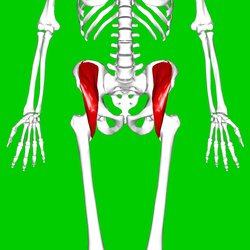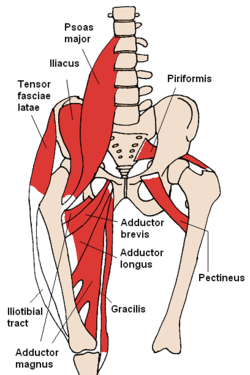| Iliacus muscle | |
|---|---|
 Position of iliacus muscle (shown in red) | |
 The iliacus and nearby muscles | |
| Details | |
| Pronunciation | /ɪˈlaɪ.əkəs/ |
| Origin | Upper two-thirds of the iliac fossa |
| Insertion | Base of the lesser trochanter of femur |
| Artery | Medial femoral circumflex artery, iliac branch of iliolumbar artery |
| Nerve | Femoral nerve |
| Actions | Flexes and rotates medially thigh [ citation needed ] |
| Antagonist | Gluteus maximus |
| Identifiers | |
| Latin | musculus iliacus |
| TA98 | A04.7.02.003 |
| TA2 | 2594 |
| FMA | 22310 |
| Anatomical terms of muscle | |
The iliacus is a flat, triangular muscle which fills the iliac fossa. It forms the lateral portion of iliopsoas, providing flexion of the thigh and lower limb at the acetabulofemoral joint.

